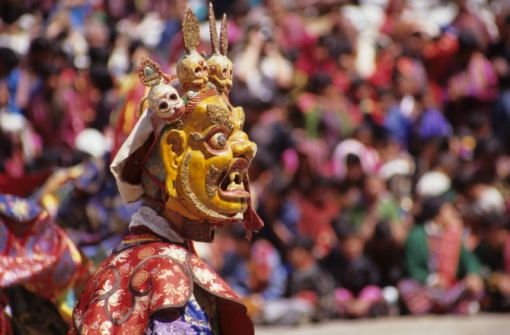
Standing by the doorway I watch, in the paved courtyard in front of me, the individual deities performing their final pirouettes for the crowd, who warmly applaud each balletic finale. As the dancers pass by me, they are displaying the more human traits of tiredness and exhaustion, a result of performing in a heavily masked costume under a warm sun for nearly an hour. This is the end of the Dance of the Terrifying Deities at the Paro Festival, one of the most important cultural celebrations in Bhutan, the Land of the Dragon, in the Eastern Himalaya.
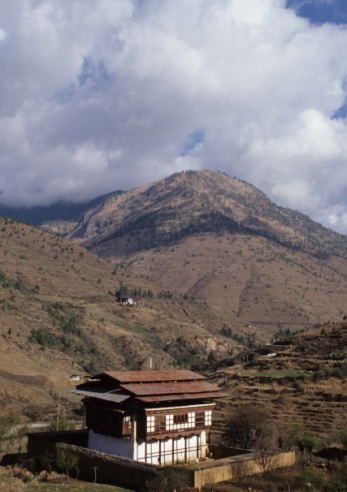
Bhutan is bordered to the North and East by Tibet/China and to the South and West by India. I flew to Paro from Kathmandu with the National Airline Druk Air, over some of the world’s highest peaks including Mount Everest. This flight gives you a teasing introduction to the hiking opportunities in this country on their wonderfully named treks: the Druk Path trek; the Bumthang Culture Trek and the strenuous Snowman Trek, a 221 mile, 3 week journey along some of the remotest and highest valleys of the northern areas of Bhutan, parts of which can be cut off from the rest of the world for six months of the year.
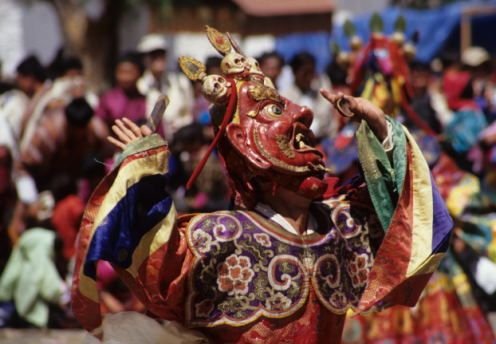
However, like me most travellers from abroad choose to attend instead one of the fascinating Tsechu festivals as part of their visit. The Paro Festival is one of the most important in the whole of Bhutan. At this Buddhist festival masked dances performed by trained monks depict events from the life of the eighth century Buddhist teacher, Guru Rinpoche (Padmasambhava). This guru is revered because he founded Tantric Buddhism, which would gradually evolve into Tibetan Buddhism over the following 400 years. He established a number of temples and monasteries, including the famous Taktshang monastery built high on a cliff face above the Paro valley, close to where the dancing occurs. Taktshang, meaning “Tiger’s nest,” is built around a cave in which Guru Rinpoche meditated. For the local people it is a place of pilgrimage and legend has it that Rinpoche flew to the site of the monastery from Tibet on the back of a tigress.
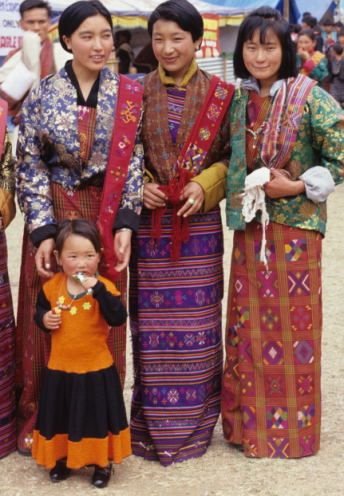
The Paro Festival provides Bhutanese from far and wide with a wonderful reason to dress up, gather together and enjoy a cultural experience in a light-hearted atmosphere. It is an occasion to renew their faith and to receive the blessing of a lama or Buddhist monk. This mixture of humour and faith is also reflected in the presence of atsaras in the dances. These clowns, who mingle on the periphery of the performance, sport fiendish masks, make lewd gestures, crack salacious jokes, and are entitled to mock both spiritual and temporal subjects, so bringing a lighter side to otherwise serious matters.
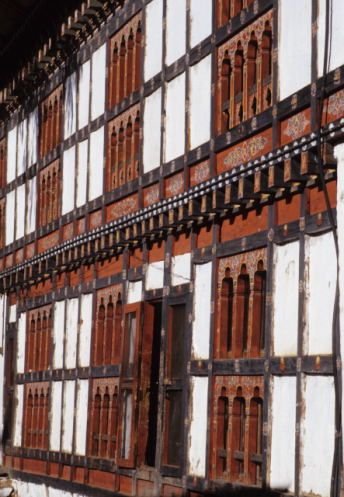
Musicians accompany every performance and play a variety of instruments from drums to high-pitched flutes. The most atmospheric is the deeply resonating yak-horn that lends an immense sense of importance and solemnity to the dances, which have evocative names, such as the Dance of the Lord of death and his consort; the Dance of the Lords of the Cremation Grounds and The Dance of the Four Stags.
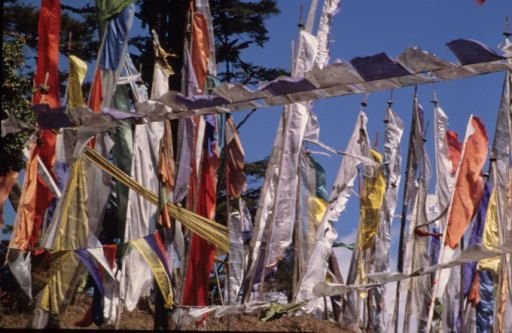
My personal favourite was the Dance of the Terrifying Deities. In this dance, each dancer’s mask is primarily of one colour, with the eyebrows high-lighted in another. The teeth are bared in an evil grimace. Every mask has five small horns, each with a skull at the base of it and each with a piece of differently coloured ribbon attached to it, which lends a sweep of drama to head movements. As a costume, the dancers wear a light coloured cape over a highly coloured brocade dress, which has flowing sleeves that mimic the pattern of the dress, as do the pants that are worn underneath. A pair of beige coloured boots completes the outfit and each participant carries a ceremonial dagger.

Tourists to the festival are provided with a program describing in English the schedule for the 5 days of dances and also a description of their religious significance and meaning. The local people are incredibly accommodating, waiting patiently while I took pictures of them in their national dress and very politely ushering me forward to get close-ups of some of the action. An outdoor market takes place at the same time as the Tsechu in the monastery grounds, where you can buy local souvenirs or foodstuffs and indulge in some rather dated gambling games which are officially frowned upon but nevertheless tolerated on such occasions as these.
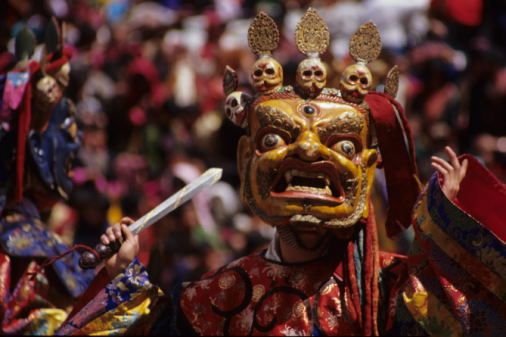
At Paro Tsechu, a large and beautifully appliquéd Thanka scroll, known in Bhutanese as a Tongdrol, is gradually unfurled from the roof of a four-storey building before dawn on the final day. This Thankha measuring 90 feet by 70 feet, embroidered in silk, is more than 300 years old. The devout line up to touch it and receive merit before it is rolled up again before the first rays of the sun hit it.
Interesting to know that part of their tradition, builds a culture that currently experienced by young generations. Thank you for sharing the fact about one of the attraction in Bhutan.
It's a lovely place, but I fear it will change gradually.
Hi! I am a robot. I just upvoted you! I found similar content that readers might be interested in:
https://www.blogarama.com/contemporary-blogs/1286150-julian-worker-writing-blog/20274955-bhutan
This is the best post on Steemit. I gave you a vote now, ya heard?
I hear you.
Your Post Has Been Featured on @Resteemable!
Feature any Steemit post using resteemit.com!
How It Works:
1. Take Any Steemit URL
2. Erase
https://3. Type
reGet Featured Instantly – Featured Posts are voted every 2.4hrs
Join the Curation Team Here
Thank you!